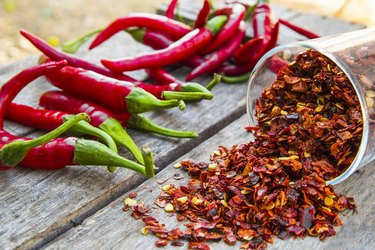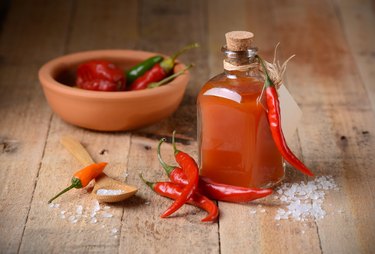
"Spice up your life" is more than a catchy Spice Girls song — it's exactly what capsaicin does to food and your body. If your mouth feels like it's on fire whenever you eat hot sauce or spicy peppers, then you're experiencing the instant effects of capsaicin.
Capsaicin is naturally found in all chili peppers, such as jalapenos, habaneros and shishito peppers. If it's a hot pepper or any food made from them (like hot sauce), it's got capsaicin, according to the University of Michigan.
Video of the Day
Video of the Day
The capsaicin content in foods is measured with the Scoville Scale using Scoville Heat Units (SHU). Pure capsaicin has 16 million SHU. Most peppers are much lower on the scale, though, usually between 1,000 SHU and 1 million SHU. The higher a pepper is on the scale, the hotter it is and the more capsaicin it contains, according to the American Chemical Society.
So, is capsaicin in all peppers? Definitely not. For example, bell peppers measure at zero SHU, meaning they don't have any capsaicin and are inherently not spicy at all.
Besides adding heat to food, capsaicin has a range of benefits and has been found to lower blood pressure, decrease post-meal blood sugar levels and increase satiety in adults, according to a July 2016 study in Molecules.
You can find capsaicin in supplements and topical creams, too. One of its main uses is for pain relief, which is where capsaicin creams and ointments come in handy. Capsaicin activates a pain receptor that signals to your brain to reduce the feeling of pain, per an October 2012 study in Pharmacological Reviews.
Despite the health benefits, capsaicin-rich hot peppers aren't for everyone. They can irritate your mucous membranes, like the lining of your respiratory system or esophagus. Also, people with irritable bowel syndrome (IBS) might experience GI issues like gas, diarrhea or stomach upset after eating spicy foods.
If you're cooking or preparing capsaicin-rich foods, handle them with care. The alkaloid can cause irritation or a burning sensation if it comes into direct contact with your eyes, open wounds or broken skin. Make sure you wash your hands with soap immediately after handling to get rid of any lingering residue.
How Much Capsaicin Do You Need?
There's no specific recommended dosage of capsaicin to get from foods. Studies looking at the benefits of capsaicin have varied greatly in the dosage they tested.
Keep reading to learn which foods have the most capsaicin. Note that the list below is based on SHUs reported by the Institute of Food & Agricultural Services at the University of Florida.
1. Carolina Reaper: 2,009,000 Scoville Heat Units (SHU)
The hottest pepper in the world is the Carolina Reaper. It was made in South Carolina by crossing a Pakistani Naga pepper with a red habanero from the West Indies.
This wicked pepper's heat level is at 2,009,000 SHU, according to the University of Florida Institute of Food and Agricultural Sciences.
2. Ghost Pepper: 1,041,427 SHU
Ghost peppers, also known as bhut jolokia, were once the hottest and most capsaicin-rich foods in the world, with 1,041,427 SHU. They even set a Guinness World Record in 2007 for being the hottest peppers.
Since then, even hotter peppers have emerged — the Carolina Reaper has double the heat.
3. Habanero: 100,000 to 350,000 SHU
Slightly more tolerable, habanero peppers have 100,000 to 350,000 SHU, so you'll get plenty of the benefits of capsaicin. These peppers are rich in antioxidants thanks to the phytochemicals they contain, like carotenoids and phenols, according to a February 2014 study in the Scientific World Journal.
Habaneros are usually yellow, orange and red and are characterized by a fruity and floral aroma. Try adding them to these protein-packed chili recipes for an extra kick.
4. Thai Pepper: 50,000 to 100,000 SHU
Thai peppers measure at 50,000 to 100,000 SHU. Their range of capsaicin and heat capacity varies because of the wide variety of Thai peppers that exist.
Thai peppers are often ground into chili flakes or chili powders. But they're also used to make curry paste and Thai curry dishes.
5. Cayenne: 25,000 to 50,000 SHU
Cayenne pepper is a capsaicin-rich food that packs some serious heat, with 25,000 to 50,000 SHU. This spicy red pepper is often dried and turned into a powder or flakes. Don't mistake it with chili powder, which is usually a blend and a lot less spicy, clocking in at 500 to 1,500 SHU.
6. Tabasco: 30,000 to 50,000 SHU

Ah, tabasco peppers — not to be confused with Tabasco-brand hot sauce. One of the main differences between the two is their capsaicin content and Scoville rating. Tabasco peppers have 30,000 to 50,000 SHU, while Tabasco red sauce only has 2,500 to 5,000 SHU.
7. Serrano: 10,000 to 25,000 SHU
Serrano peppers appear similar to jalapenos but are somewhat thinner and shorter. But, what serranos lack in size, they make up for in heat (and capsaicin), with 10,000 to 25,000 SHU. Because of their bright, spicy flavor, these peppers are often used in hot sauces, garnishes and salsas (pico de gallo, anyone?).
Add serrano pepper to these breakfast skillet recipes to spice up your morning.
8. Jalapeno: 2,000 to 8,000 SHU
Jalapenos are small to medium-sized peppers that are popular around the world. They have a bite, thanks to 2,000 to 8,000 SHU, but they're much milder than habanero and cayenne peppers.
Jalapenos are also a good source of antioxidants like vitamin C, providing 18 percent of the daily value, per the USDA. Try them in these cozy jalapeno dinner recipes.
9. Poblano Pepper: 1,000 to 2,000 SHU
Poblanos are mild, large green peppers that contain much less capsaicin than the other foods on the list, with only 1,000 to 2,000 SHU. These peppers lack the intense heat of the other peppers on this list, making them an easy addition to your diet if you're not a spice fanatic.
Poblanos are a staple in Mexican cuisine. They are often roasted and stuffed with meat or beans. Poblanos can also be dried to make ancho chilies and then used to make flavorful mole sauces.
Related Reading
- University of Michigan: "Capsaicin"
- American Chemical Society: "Hot Peppers: Muy Caliente"
- Molecules: "Capsaicin: Current Understanding of Its Mechanisms and Therapy of Pain and Other Pre-Clinical and Clinical Uses"
- Pharmacological Reviews: "Unravelling the Mystery of Capsaicin: A Tool to Understand and Treat Pain"
- Institute of Food & Agricultural Services at the University of Florida: "Peppers Ranked by Heat"
- University of Florida's Institute of Food and Agricultural Sciences: "Pepper Production in Miami-Dade County, Florida"
- Scientific World Journal: "Antioxidant Capacity and Total Phenolic Content in Fruit Tissues from Accessions of Capsicum chinense Jacq. (Habanero Pepper) at Different Stages of Ripening"
- USDA: "My Food Data"